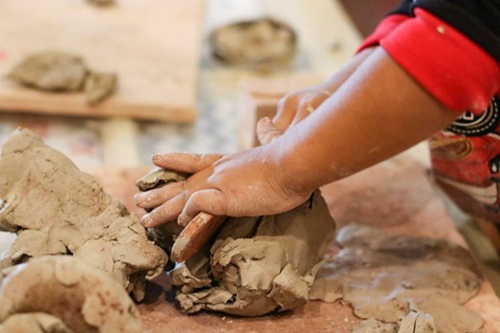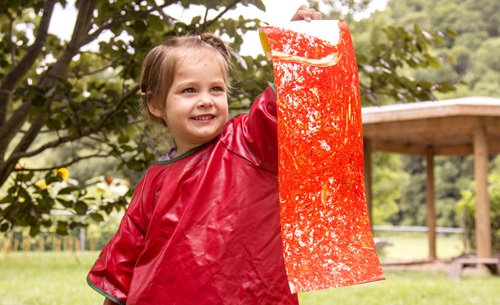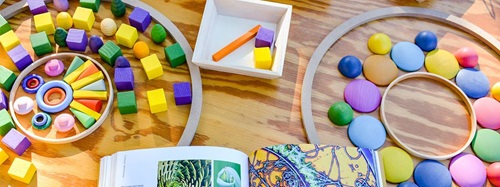The Learning in Loose Parts
| March 2015In a world in which we are preparing our youngest generation for professions still unknown, it is imperative to fuel children’s curiosity and appetite for learning. This love of learning, along with the skills to communicate, problem-solve, and self-regulate, will lead to life-long success no matter the profession. Some might say that learning these skills will only happen behind a desk in a typical classroom, but Dimensions Educational Research Foundation’s research tells us that children who spend time in well-designed, nature-filled outdoor classrooms develop skills across all learning domains (Miller 2007).
This finding is based on over a decade of Dimensions Foundation research in Nature Explore Classrooms across the nation. It also adds to the growing body of evidence that substantiates that, for young children, play is learning, and intentionally designed outdoor spaces provide powerful contexts for children’s growth and development. What makes an outdoor classroom different than the traditional classroom? For one thing, the availability of nature’s loose parts.
Nature’s Loose Parts Support More Complex Play
Architect Simon Nicholson used the term “loose parts” to describe materials with varied properties that can be moved and manipulated in many ways. He theorized that the richness of an environment depends on the opportunity it allows for people to interact with it and make connections. Early childhood educators have found this to be true and have documented the vast learning that can occur when children are able to invent, create, explore, and rearrange loose parts.
With no specific set of directions—and powered only by a child’s imagination—an assortment of shells might become a collection to sort, scoops to move sand, or saucers placed for tea. Further illustrating that the materials we provide children should be open-ended, Joan Almon, former director of the Alliance for Childhood, suggested that a good toy is really only 10% toy and 90% child (cited in Linn, 2008).
When children are encouraged to use loose parts and try their own ideas, they are driven to learn. They are driven to not only ask their own questions, but also discover their own answers and create new possibilities. A child’s play with loose parts even begins to match their developing skill level (Daly and Beloglovsky, 2015), providing opportunities for divergent and creative problem solving.
The natural world in all its simplicity and complexity affords children a rich allure of play and learning experiences. Nature organically produces a spectrum of loose parts that exhibit patterns and sequences not easily replicated in man-made materials. Consider the intricate patterns of a pinecone or the spirals of an unfurling fern. Notice the diversity and textures of tree bark and the way it provides a home for insects. These relationships can be discovered, tested and understood hands-on, the way children learn best. With a higher level of complexity and variety, nature offers the materials that support longer and more complex play (White and Stoecklin, 2014).
A Natural Environment for Loose Parts
For many of our children—especially those with little experience outdoors—a wild, untouched natural environment might seem overwhelming at first. A more organized and accessible natural environment can allow children to feel safe, as they use nature’s loose parts to understand the world. And let’s face it; completely wild areas are not readily available where most children spend the bulk of their day. Creating a nature-filled outdoor playspace that children can access daily transforms both their behavior and their attitudes about nature at the same time.
Dimensions Foundation examined the optimal characteristics present in an outdoor space to support early childhood development. The results indicate that the natural world serves as a unique and powerful setting for learning. We found that children regularly engage with each other and develop holistically when the space is:
- clearly delineated to support multiple skill levels and interests,
- organized in a way children can understand,
- equipped with nature’s loose parts and tools to explore, and
- accompanied by nurturing adults to scaffold those experiences.
Through direct observation of children’s work in Nature Explore Classrooms, enhanced skill development in science, math, language and literacy, music and movement, art, visual spatial, and social skills were documented. This research was conducted in Nature Explore Classrooms at sites around the country, representing different environments, populations, and demographics with remarkably similar results. Two of the key themes that emerged from this research over time included the importance of well-designed nature-filled spaces and the value of nature’s loose parts.
In Dr. Samuel Dennis’ post-occupancy study of natural outdoor classrooms (2014), he notes that children in outdoor classrooms find their play to be supported both through the natural and the structural environment. He states, “Nature provided far more play props and open-ended play opportunities than sites with fixed equipment set in large areas of safety surfacing.” Dennis concludes, “Children in natural settings were reported to be more relaxed, focused, engaged, cooperative, creative, nurturing, and happy compared to children in indoor classrooms or on traditional playgrounds. Nature-based early childhood learning environments provided opportunities for children to experience the changing seasons and observe the life cycles of plants, animals, and insects, while providing natural materials for exploration and play.”
To make further sense of the environment and materials used by children in the Nature Explore Classroom, it is helpful to think about the ways in which children’s play was affected by the properties of natural materials. These properties have been referred in the context of affordances. For example, “If a rock has a smooth, flat surface, it affords a person to sit; if a tree is well branched it affords the opportunity for a person to climb it” (Lester and Maudsley, 2007, p. 27). In essence, affordance allows children to match material properties to their own behavior (Bohling, Saarela, and Miller, 2010).
Skill Development with Nature’s Loose Parts and Teacher Support
Dimensions Foundation research suggests that the combination of intentionally designed spaces and ample natural materials allows children to demonstrate their knowledge of the world in unique ways. In our studies, we found that the access children had to a large amount of diverse natural materials allowed for a broad range of skill development. Children used many open-ended loose parts in the Nature Explore Classrooms. This supported problem solving, imagination, and creativity in ways that would not likely have occurred on a traditional playground or indoors. Sophisticated critical thinking occurred as children intentionally selected natural materials to serve as their props during their pretend play. How different their play would have been if they had not had these materials or, for example, if teachers had provided them with pre-formed props so they did not have to engage in this kind of intellectual and imaginative thinking.
In Nature Explore Classrooms, outdoor play is no longer a time when staff stand back, detached from the action, and supervise from a distance. Rather, the outdoor classroom becomes a purposeful space for teaching and learning across the curriculum, as has been documented at other sites (Thompson & Thompson, 2007).
In well-designed outdoor classrooms, children have the power to transform simple objects into complex objects for a variety of uses. Why is this kind of symbolic thinking (i.e., creative representation) so important? Hirsh-Pasek and Golinkoff (2003) believe that it is crucial because children need to develop the ability to think beyond the objects that are concretely in front of them if they are going to learn to combine new ideas in creative ways. “Treating objects as though they were something else is the beginning of that important ability. And being able to use objects symbolically, to stand for something other than what they really are, is related to children’s language progress” (p. 209). Researchers Talbot and Frost also suggested that “when an object or environment is open to many interpretations and uses,” children “hold the power to tell it what it is to be or do” in lieu of being given one “preconceived ‘correct’ way” to view something (cited in Hohmann & Weikart, 1995, p. 111).
Dana Miller (2007) sums up what Dimensions Research says about the value of natural loose parts in this way:
Our research presents compelling evidence that providing children with open-ended natural materials fosters imagination, creativity, and symbolic (abstract) thinking. When they are working with open-ended materials children get to decide what those materials will become, explore interesting ways to manipulate the materials, and how their use of those materials may change during a dramatic play scenario. Children get to search for just the right material or object to represent something in their minds, and through that use and the functions they assign to those materials, children display their brilliance.
As we educate our children for an unknown future, we can feel confident in supporting them daily in organized outdoor classrooms filled with loose parts and curious, caring adults ready to learn alongside them.
To learn more about Dimensions Foundation’s research, visit www.natureexplore.org .
Works Cited
Bohling, V. Saarela, C., & Miller, D. (2010). This never would have happened indoors: Supporting preschool-age children’s learning in a Nature Explore classroom in Minnesota. Dimensions Educational Research Foundation.
Daly, L., & Beloglovsky, M. (2015) Loose parts: Inspiring play in young children. St. Paul, MN: Redleaf Press
Dennis, S.F., Wells, A. & Bishop, C. (2014). Children, Youth and Environments, Vol. 24, No. 2, Greening Early Childhood Education, pp. 35-52
Hirsh-Pasek, K. & Golinkoff, R.M. (2003). Einstein never used flashcards.Emmaus, PA: Rodale.
Hohmann, M. & Weikart, D. (1995). Educating young children. Ypsilanti, MI: High/Scope Press.
Lester, S., & Maudsley, M. (2007). Play, Naturally: A Review of Children's Natural Play. Los Angeles: National Children's Bureau Enterprises Ltd.
Linn, S. (2008). The case for make-believe: Saving play in a commercialized world. NY: The New Press.
Miller, D.L. (2007). The seeds of learning: Young children develop important skills through their gardening activities at one Midwestern Early Education Program. Applied Environmental Education and Communication, 6, 49-66.
Thompson, J. E., & Thompson, R. A. (2007, November/December). Natural connections: Children, nature and social-emotional development. Exchange, pp. 46-49.
White, R. & Stoecklin, V. (2014). Children’s outdoor play and learning environments: Returning to nature. Accessed 2015 at www.whitehutchinson.com












